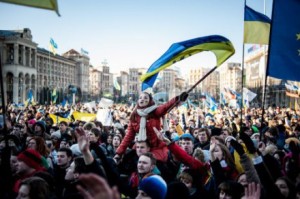By Halyna Aleksandrovych
UCR Class of 2015
The 22nd of November, Kiev experienced a flashback to the start of the  Orange Revolution, nine years ago to the day. Tens of thousands went into the streets to protest the Ukrainian government’s sudden decision to halt negotiations with the EU to establish a free trade zone with Ukraine. This Association Agreement would have allowed for closer relations between Ukraine and the West. The government’s official reason for not signing the agreement was to “defend the nation’s economic interests” as Russia threatened to impose sanctions.
Orange Revolution, nine years ago to the day. Tens of thousands went into the streets to protest the Ukrainian government’s sudden decision to halt negotiations with the EU to establish a free trade zone with Ukraine. This Association Agreement would have allowed for closer relations between Ukraine and the West. The government’s official reason for not signing the agreement was to “defend the nation’s economic interests” as Russia threatened to impose sanctions.
In 1654, the Cossacks, which included Ukrainians, signed a fairly straightforward agreement with the Russian tsar to unite against the Poles. This move marked the beginning of Russia’s control and rule over Ukraine, which lasted until the fall of the Iron Curtain.
Whether Ukraine is now oriented towards the West or Russia depends on several factors. Due to geographical proximity to Russia as well as “russification” during the USSR, there is still a large part of the country’s population that are pro-Russia, including the East and Southern parts and especially the elderly. However, it also depends on the issue. For instance, many pro-Russians support the current protests for economic reasons.
The current protests started November 21st and grew throughout the week, both in Kiev and around the country. They consisted of the opposition – made up of three political parties, students gone on strike, and a group of regular citizens and nationalist civil leaders, including writers, journalists, historians, and many who participated in the protests of 1991 and 2004-2005. Ukrainians have stated they wish to live in a country that follows the rule of law, respects human rights and promotes equal opportunity, and is ruled by an uncorrupt government, which is not influenced by the Kremlin. This is interesting to note, as the Association Agreement has predominantly addressed economic issues.
These protests are different than the Orange Revolution because of social media. Within 24 hours, there was a Facebook page, and twitter featured the hashtag “EuroMaydan” (“maydan” means square) because most of the protests have taken place on Maydan Nezalezhnosti (“independence”) Square. Protesters came armed with smartphones and there have consistently been live streams covering the main events.
Although the protests have been predominantly peaceful, some clashes have taken place. At 4am on November 30th, around a thousand protesters remained in the main square and were attacked by riot police. The police’s official reason was to “clear the square to set up the Christmas tree”. This resulted in public outrage and since then there have been upwards of a hundred thousand protesters in Kiev, with some estimating that as many as 700,000 have shown up at some point.
The issue remains very complex. It is important to stress that the vast majority of protests have been peaceful and organized. Volunteers have organized security, food, shelter, medic groups, entertainment, etc. The violence has predominantly occurred by government buildings, and journalists have been targeted. Some riot police have beat people, while others have been rather restrained even as bricks were thrown at them. Groups of buff men wearing masks have been seen taking more radical measures, with many speculating whether they are more extremist protesters or government-hired thugs to discredit the demonstrations or provide a reason to call a state of emergency.
It will take time to fully understand what is happening, but some conclusions can already be made. It is too late for the government to make concessions. Their recent attempts at action have only angered people further. Moreover, with the protests overlapping with the anniversary of the Orange Revolution, their timing could not have been worse as December 1st marks the day when over 90% of Ukrainian voted in favor of independence in 1991.
However, the situation needs to be controlled fast, before it escalates into countrywide riots. So far, peaceful individuals have been able to contain the violence, and have even gone so far as protecting the riot police from extremists. However, the population is growing restless waiting for the opposition party to step up. Vitali Klitschko commands enough respect to do that, but he has very little time. Let’s not let what started as a peaceful demonstration with the best intentions turn into worst of riots.
Halyna Aleksandrovych, Class of 2015, is a Politics and Law major from Kiev, Ukraine.
